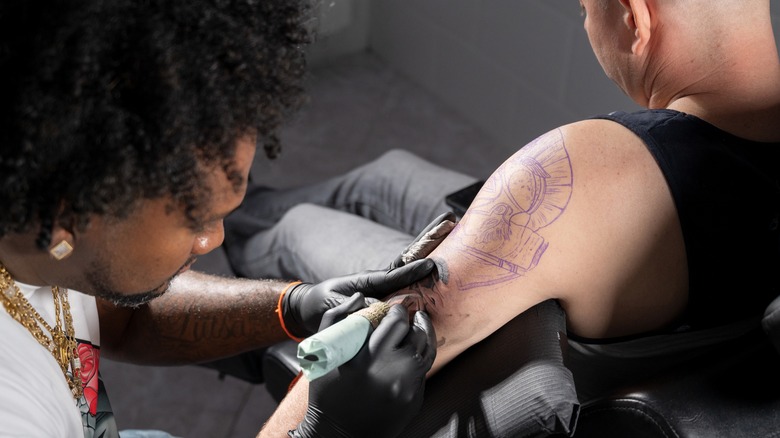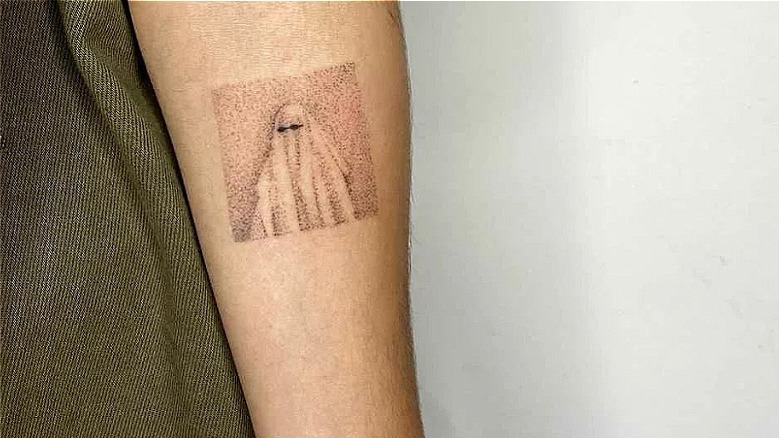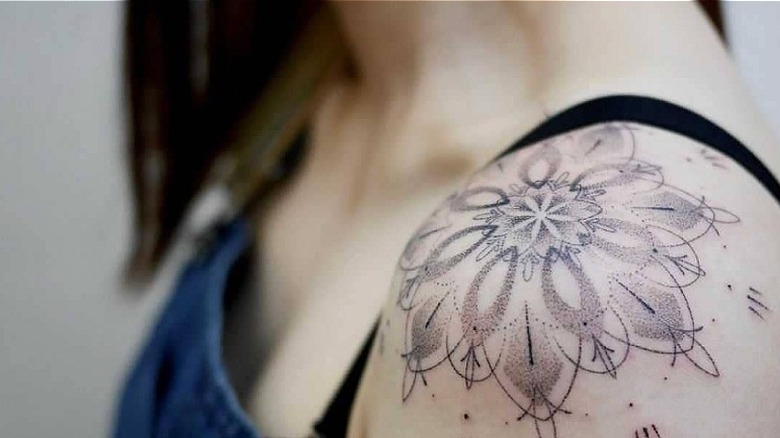What You Should Know About The Dotwork Tattoo Trend
Well over a century ago, French artist Georges Seurat used a fine-pointed brush to capture a Sunday afternoon in the park. The painting, entitled "A Sunday on La Grande Jatte," pioneered the post-impressionist style known as pointillism, a collection of rigorously-organized and colorful dots used to create distinct figures when viewed from a distance (via Art Institute Chicago). However, Seurat was far from the first artist to use this technique.
In fact, the origins of pointillism can be traced back thousands of years to the tattoo traditions within Asian, Maori, and Egyptian communities, per Vivid Ink. As noted by McGill, some form of tattooing has been present in nearly every society in human history. Within the Mayan Empire, for instance, tattooing served a spiritual purpose, often indicating bravery and sacrifice due to the high possibility of infection, according to Medium.
For the early Britons, per McGill, tattooing was part of select ceremonies. BBC quotes Julius Caesar's accounts of the Gallic Wars: "All the Britons dye themselves with woad," he writes, noting how it "produces a blue color, and makes their appearance in battle more terrible." Dotwork tattoos, specifically, have historically been used for religious, cultural, and, as Smithsonian magazine suggests, even therapeutic purposes.
For instance, some ancient Egyptian women may have used dotwork as a visual safeguard during pregnancy, a method of protecting the baby inside the womb. Now, thousands of years later, a modern form of dotwork is growing increasingly popular, with these highly-detailed designs popping up worldwide.
Dotwork tattoos take much longer to complete
If you're particularly wary of needles, dotwork might not be the best choice. Though an electric tattoo machine can be used to create dotted shading, Skin Factory Tattoo clarifies that most artists use a hand-poked method for dotwork designs. Hand-poked tattoos, aka "stick and poke," work as the name suggests — a needle is used to meticulously "poke" ink into the skin, point by point (via Byrdie).
This process takes longer than an electric, multiple-needle machine, therefore extending any pain you may feel during the appointment. Much like Seurat with his paintbrush, the artist is creating an image one pinprick at a time. Also due to the additional time, these designs typically cost more. However, the level of detail you'll receive with the dotwork method is unmatched — just make sure you're booked with a qualified artist.
As tattooist Burak Noire warned Byrdie, "Please never get a stick-and-poke tattoo in a friend's kitchen or underground so-called private studios. It is still a serious procedure." According to Lorena Lorenzo, a Toronto-based tattoo artist who spoke to Bustle, "The concern in the past was the fine details bleeding together but with the right artist, this can be avoided."
It should be noted that tattoos placed on fingers, feet, knees, and elbows fade quicker due to the skin's ability to regenerate in these areas, per ABC Every Day. You might be surprised to learn what happens to your body when you get a tattoo in general, in fact.
Dotwork designs don't usually involve color
As Skin Factory Tattoo explains, color isn't typically associated with dotwork tattoos. It's most common to see black, gray, or dark blue designs in this style. Some artists use dotwork solely for shading in a process known as stippling (via Chronic Ink). Though hand-poked techniques can be used to capture any image, Skin Factory Tattoo notes that most examples have some sort of spiritual significance.
Mandalas, for instance, are a common dotwork request, but many customers also opt for hamsa or lotus designs, according to Bustle. In regards to these spiritual tattoos, Gorilla Tattoo Paphos owner Nic El explained, "They are deeply associated with healing, balance, growth, rebirth, and positive energies, therefore many people associate with them."
Because hand-poked tattoos are so time intensive, most dotwork artists specialize in geometric rather than hyper-realistic designs — few tattooists will be eager to recreate "A Sunday on La Grande Jatte," for example. Not only is the amount of detail overwhelming, but the bright colors aren't necessarily conducive to a stick-and-poke appointment.
The bottom line? Before you get any tattoo, there are several things to consider — the possible cultural significance of your chosen design, the pain factor, and the cost, for starters. But no matter what, always ensure you go to a reputable artist.


